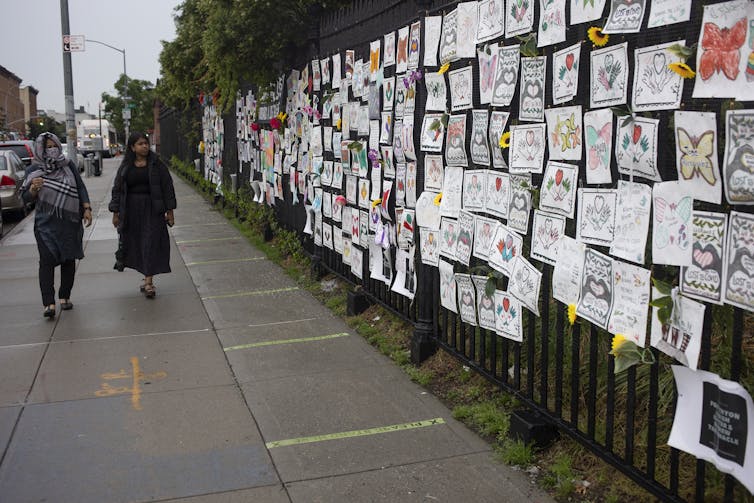Six months ago, it was easy for many Americans to think COVID-19 was on the defensive. Vaccinations were ticking up as case numbers ticked down. Summer sunshine made hanging out outside actually enjoyable, after a cooped-up winter of socializing with just our pods. Maybe, just maybe, Zoom fatigue would soon be a thing of the past.
Today, that optimism seems miles away. Hospitalizations are hitting new highs. Concerns about school safety amid climbing case counts have working parents and teachers on edge.
If you’re not exactly feeling hopeful about the year ahead, you’re not alone. Here are five of our favorite stories spotlighting resilience, healing, and yes, hope, to help you face 2022.
1. ‘Work with hope’
Face it, poet and classics scholar Rachel Hadas writes: “We’re in a prolonged period of maddeningly, scarily bad news.”
But if you think that makes our society unique, think again. For as long as humans have been writing, they’ve been facing crises, learning to adapt – more than we give our species credit for – and keeping hope afloat. And readers today can draw strength from yesterday’s literature.
Whether it’s Homer’s Greek epic “The Iliad” or American poet Emily Dickinson, writing about resilience often shares key themes, Hadas says: learning to balance the present and the future, the big-picture horizon and the joy of small things along the way. Quoting the modern Greek poet George Seferis, she writes of the need to “put to sea again with our broken oars.”
2. Before healing, remembering
The pandemic has robbed people not only of joy, but also of ways to process grief. As many people grasp “every opportunity to reconnect” and find new normals, others are still mourning lost loved ones, especially if COVID-19 restrictions prevented the kinds of healing and commemoration families once took for granted.

Eventually, as the pandemic ebbs, both groups can find happiness, but in different ways, writes David Sloane, who studies commemoration and mourning practices.
With normal healing interrupted, “ everyday memorials” from flags and photographs to tattoos can help people “transition from the depths of the pandemic to the reopened society by offering ways for them to mourn and remember.”
As we recover, joy and grief are often mixed together, he says, but don’t let “survivor’s guilt” keep you from finding comfort.
3. Lean in to rituals
Across cultures, rituals can mark life milestones, strengthen social ties and even promote hygiene – such as Wudu, ritual cleansing before prayers in Islam. Yet the pandemic has interrupted everyday rites like handshakes and hugs, not to mention once-in-a-lifetime events like weddings or bar mitzvahs.
But that presents an opportunity to adapt, writes psychologist Cristine Legare. People often rely on rituals to manage stress and exert control, which helps them deal with uncertainty – part of what’s so overwhelming about the pandemic.
“There are good reasons people spend time, money and energy engaging in rituals in the face of COVID-19 restrictions,” she writes. “They are essential to meeting our physical, social and psychological needs in the face of adversity.”
4. Hope vs. optimism
Hope isn’t expecting good things, psychologist Jacqueline Mattis clarifies: It’s believing they’re possible, and then creating paths to achieve them. In other words, having a plan.
She offers five strategies to actively cultivate hope: having goals, harnessing uncertainty, managing attention, seeking community and looking at evidence. Challenges like a global pandemic call for adapting, not giving up, and “uncertainty is not reason for paralysis – it is a reason to hope,” Mattis writes.
“Hopeful people do not wish – they imagine and act,” she writes, emphasizing the importance of acting in community. Research on anti-poverty activists, for example, underscores that their relationships ignited their hope and conviction, giving them “a sense of accountability, to recognize that their work mattered and that they were part of something bigger than themselves.”

5. Get in the flow
For people still crafting their 2022 resolutions, cognitive scientist Richard Huskey has a suggestion: Add some flow.
It’s on his own list, too. “Flow,” a term coined in the 1970s by psychologist Mihály Csíkszentmihályi, is that feeling of complete absorption, or intense concentration, when someone’s thoughts “are focused on an experience rather than on themselves,” Huskey explains.
Intrinsically rewarding experiences, like those that put us “in the zone,” support mental health, well-being and resilience. In fact, a study from China shows that people with more “flow” in their lives “had better well-being during the COVID-19 quarantine.”
Editor’s note: This story is a roundup of articles from The Conversation’s archives.![]()
This article is republished from The Conversation under a Creative Commons license. Read the original article.




